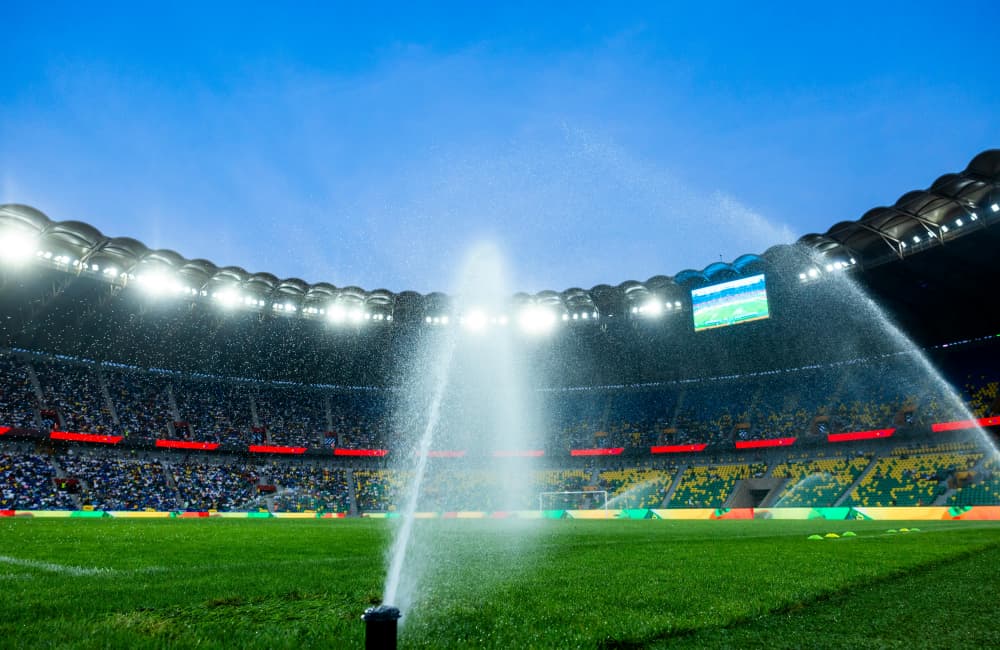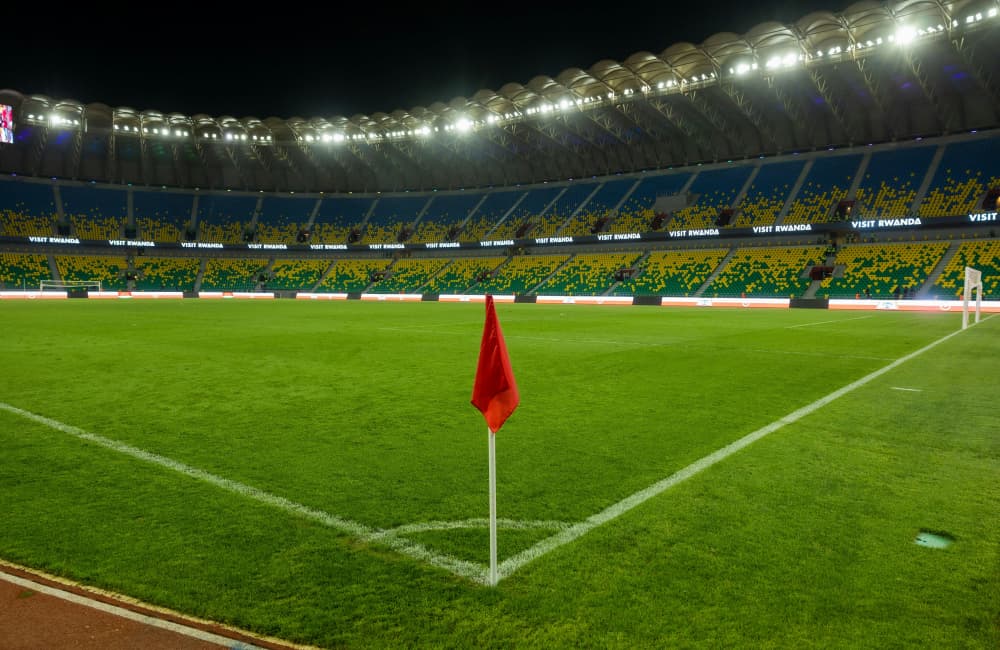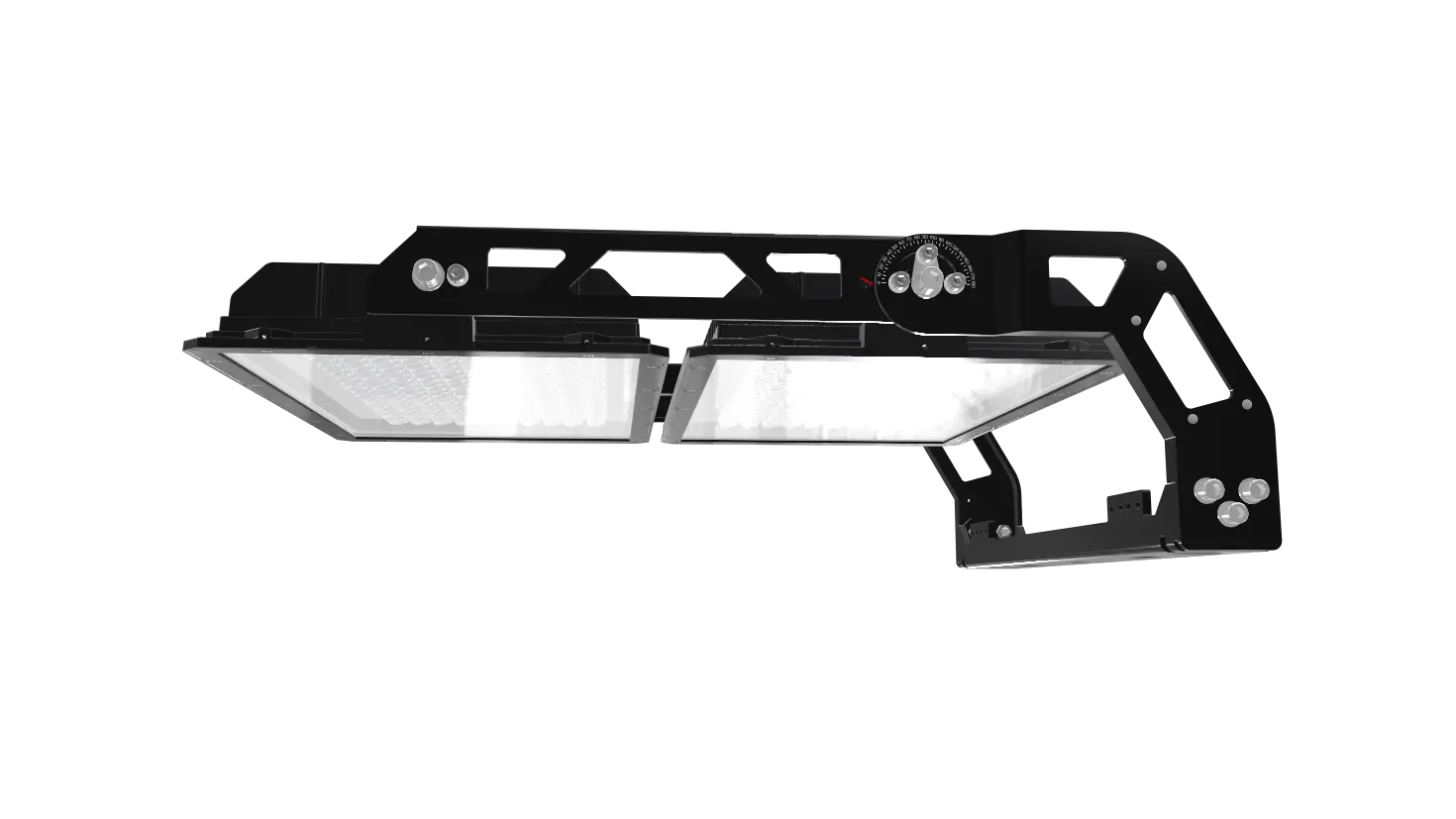Guide d'éclairage des terrains de football : conception et coût de l'éclairage LED
L'éclairage peut être déterminant pour la réussite ou l'échec d'un match de football. Des terrains communautaires aux stades nationaux, l'éclairage des terrains de football est essentiel à la visibilité, à la sécurité et même aux performances des joueurs. Pourtant, de nombreux gestionnaires d'installations sont encore confrontés à des solutions d'éclairage obsolètes, coûteuses à entretenir et dont la luminosité est inégale.
Si vous rénovez ou concevez un terrain, ce guide vous aidera à apprendre à choisir et à concevoir un éclairage de terrain de football à LED qui répond aux normes professionnelles, économise jusqu'à 70 % d'énergie et offre une visibilité parfaite pour les joueurs et les spectateurs.

Annuaire:
1. Que sont les lumières des terrains de football ?
2. Quelles sont les exigences d’éclairage pour un terrain de football ?
3. Comment éclairer un terrain de football : notions de base de conception et d'aménagement
4. Comment choisir le bon éclairage LED pour terrain de football ?
5. Combien coûtent les éclairages des terrains de football ?
6. Conclusion : Égayez le jeu avec Ceramiclite
1. Que sont les lumières des terrains de football ?
L'éclairage est essentiel à chaque match de football nocturne. Sans un éclairage adéquat, même le meilleur stade perd de sa magie. Les projecteurs de terrain de football, aussi appelés projecteurs de stade ou projecteurs sportifs, sont de puissants équipements extérieurs conçus pour couvrir uniformément de vastes zones de jeu, permettant aux joueurs, aux arbitres et aux spectateurs de voir clairement chaque mouvement.
1.1 Définition et fonction principale
En termes simples, les éclairages de terrain de football sont des projecteurs LED à haute intensité conçus pour fournir une luminosité uniforme sur tout le terrain.
Ils remplissent trois fonctions essentielles :
1 Visibilité : permet aux joueurs et aux fans de suivre une action rapide.
2. Sécurité : Prévenez les accidents en éliminant les taches sombres et l'éblouissement.
③ Qualité de diffusion : assurez-vous que les caméras capturent des images claires et aux couleurs précises pour la télévision ou le streaming en ligne.
Un terrain de football typique de taille normale nécessite six à huit poteaux d'éclairage, chacun équipé de plusieurs luminaires qui projettent la lumière selon des angles de faisceau spécifiques pour éviter l'éblouissement et le chevauchement des ombres.

1. 2 Anatomie d'une lumière de terrain de football
Un éclairage LED professionnel pour terrain de football comprend :
a. Modules LED : fournissent une lumière directionnelle brillante.
b. Lentilles optiques : contrôlez l’angle du faisceau (généralement 15°–60°) pour une couverture ciblée.
c. Dissipateur thermique : maintient la température stable, prolongeant ainsi la durée de vie des LED.
d. Protection du pilote et des surtensions : Maintenez des performances constantes en cas de fluctuations de tension.
e. Boîtier : Boîtier en aluminium ou en acier inoxydable avec indice d'étanchéité IP66+, protégeant contre la pluie, la poussière et la corrosion.
Chaque composant contribue à un éclairage stable et sans scintillement, indispensable pour la diffusion HD et les rediffusions au ralenti.
Now that we've covered what football field lights are, let's explore the lighting requirements and standards every field should meet to ensure professional-quality visibility.
2. What Are the Lighting Requirements for Football Field?
Lighting a football field isn't just about brightness — it's about balance, clarity, and consistency. A well-lit field lets players react faster, fans see clearly, and cameras capture every goal in detail.
So, before choosing LED football field lights, it's worth understanding the basic requirements that guide every professional design.
2.1 The Core Metrics That Define Good Football Lighting
A. Illuminance (Lux Levels)
Football fields are typically designed with an average horizontal illuminance between 300–2500 lux, depending on use:
Training or school fields: 300–500 lux
Amateur competition: 500–800 lux
Professional matches: 800–1500 lux
Televised events: 1500–2500 lux
Higher lux ensures better visibility of fast-moving balls and players, especially under HD broadcasting.
B. Uniformity (U1/U2 Ratio)
Uniform lighting avoids bright or dark spots across the pitch.
Target uniformity: ≥0.6 (U1) and ≥0.7 (U2).
When light is evenly distributed, players' eyes adjust naturally and visual fatigue decreases.
C. Color Temperature (CCT)
Most football fields use 5000–6000K, a daylight-like white that enhances color contrast and realism on camera.
D. Color Rendering Index (CRI)
A CRI ≥80 is recommended. This ensures jerseys, turf, and ball colors look true to life under LED light — an important factor for spectators and broadcasters alike.
2.2 Standards You Can Refer To
Different organizations set clear standards for sports lighting performance.
The most recognized are:
l FIFA (Fédération Internationale de Football Association) – for professional football stadiums.
l CIE (International Commission on Illumination) – defines lighting quality principles for all sports.
l IES (Illuminating Engineering Society) – commonly used in the U.S. for design reference.
According to FIFA's Football Stadium Lighting Guide and CIE 121:2018, fields are categorized into three classes:
Class | Application | Average Horizontal Illuminance (lux) | Uniformity (Emin / Eavg) | Color Rendering (CRI) |
Class III | Training / Recreational | 200–300 lx | ≥ 0.5 | ≥ 70 |
Class II | Amateur / Semi-professional matches | 500–750 lx | ≥ 0.6 | ≥ 80 |
Class I | Professional competition / TV broadcasting | 1000–2000 lx | ≥ 0.7 | ≥ 80–90 |
3. How to Light a Football Field: Design & Layout Basics
Designing football field lighting isn't just about picking bright fixtures — it's about precision.
A field that looks great on paper may fail in real play if the lights are uneven, glaring, or poorly aimed.
This chapter walks you through the essential design and layout principles for football field lighting, helping you plan a system that performs consistently for years.

3.1 Start With the Right Lighting Goal
Before you begin designing, define your goal. Lighting requirements change depending on how the field will be used:
Quick Tip: Higher-level competitions not only need more brightness but also better uniformity and color rendering for both visibility and TV broadcast.
3.2 Pole Layout: Even Light Starts With Smart Positioning
Pole placement directly impacts uniformity and glare control.
A well-designed system ensures every corner of the pitch is evenly lit.
Common layouts:
4-pole layout: Suitable for training grounds or small community fields. Two poles per sideline.
6-pole layout: The most cost-effective for amateur matches — 3 poles on each long side.
8-pole layout: Standard for professional football fields. Allows better light distribution and reduces shadows near the goals.
Hybrid layout (6+2 corner poles): Used for televised stadiums that require high vertical illumination for camera angles.
Key parameters:
Pole height: 18–30 m depending on field size and lighting level.
Distance from sideline: 5–10 m away to minimize glare and ensure beam spread.
Tilt angle: 20–30° is ideal for achieving balanced vertical and horizontal illuminance.
3.3 Beam Angle and Optics: Direct the Light, Don’t Waste It
The goal is to light the players, not the sky. Choosing the right optics and aiming angles helps achieve this efficiently.
Narrow beams (10°–30°): Ideal for long-throw applications or high poles.
Medium beams (30°–60°): Best for mid-field illumination.
Wide beams (60°–90°): Used near sidelines or corners to fill gaps.
Ceramiclite's LED football field lights use precision beam control lenses that achieve ±3° aiming accuracy, ensuring maximum light hits the target area and reducing spill light by up to 30%.
3.4 Balancing Horizontal and Vertical Illuminance
Many first-time planners only focus on ground brightness (horizontal lux). However, vertical illuminance — the light on players' faces and bodies — is equally critical for spectators and camera views.
Horizontal illuminance: ensures the field is evenly bright for play.
Vertical illuminance: ensures faces and movements are visible from multiple camera angles.
A good football lighting design aims for vertical illuminance ≥70% of the horizontal level for professional fields.
3.5 Glare Control and Light Pollution Reduction
Too much brightness can cause more harm than good. Glare affects both players and neighbors around the stadium.
To minimize it:
Use anti-glare visors or asymmetric optics.
Keep pole height adequate — higher poles = lower glare angles.
Adjust aiming angles using simulation software before installation.
Comply with CIE 150:2017 light pollution guidelines.
Ceramiclite's sports lighting series adopts low-glare design optics and shielded modules, ensuring compliance with FIFA and EN standards while keeping the night sky dark-friendly.
3.6 Simplify the Process With Lighting Design Software
Modern lighting design relies on simulation tools like Dialux or Relux, which calculate lux distribution, glare (GR), and uniformity before installation.
A quick simulation helps you:
(1) Test different pole layouts and angles
(2) Predict lighting results
(3) Optimize for cost vs. performance
Ceramiclite's engineering team provides free lighting design support — simply share your field dimensions and lighting goals, and they'll deliver a complete photometric layout plan within 48 hours.
In summary:
Effective football field lighting design is a balance between science and precision. It requires understanding how each fixture, beam angle, and pole position affects the total illumination pattern.
With a thoughtful layout and the right LED fixtures, you'll achieve perfect visibility, lower power costs, and long-lasting performance — all essential for modern stadiums and sports facilities.
4. How to Choose the Right LED Football Field Lighting?
Selecting the right LED football field lighting isn't just about brightness—it's about precision, performance, and long-term reliability. A well-chosen lighting system ensures players, referees, and spectators all experience the game clearly and safely. Here's what to focus on:
4.1 Match the Lighting Level to the Field’s Usage
Different football fields require different illumination levels.
Recreational fields: 200–300 lux is usually enough.
Training or community matches: Around 500 lux provides balanced visibility.
Professional stadiums or TV broadcast fields: 800–1200 lux ensures clear, flicker-free visuals for cameras.
Before purchasing, identify your field’s purpose—this determines how powerful your lights need to be.
4.2 Prioritize High Efficiency and Low Glare
Modern LED lights deliver more lumens per watt than traditional metal halide fixtures. Look for:
High efficacy (≥150 lm/W) for energy savings.
Anti-glare optical lenses or asymmetric beam designs to protect players' vision.
Uniform light distribution (U₀ ≥ 0.6) to avoid dark patches.
Efficient optics and glare control help balance brightness with comfort.
4.3 Check Color Rendering and Temperature
For sports lighting, color accuracy matters.
CRI ≥ 80 allows players and referees to distinguish uniforms and the ball clearly.
Color temperature 5000–5700K provides crisp daylight-like illumination that enhances visual clarity.
If the field is used for TV broadcasting, always confirm that the LEDs support flicker-free performance at high frame rates.
4.4 Consider Beam Angles and Mounting Heights
Light design depends on pole height and beam spread:
Wide beams (60–90°): For lower poles and small training fields.
Narrow beams (20–40°): For tall poles and large stadiums.
The right combination ensures the light reaches the field evenly without wasting output in the sky or stands.
4.5 Choose Durable, Weatherproof Fixtures
Outdoor football fields face harsh weather—your lights should handle it.
IP66 or higher for full protection against rain and dust.
IK08 or higher for impact resistance.
Die-cast aluminum housing and anti-corrosion coating extend service life.
Durability is especially important for coastal or humid regions where corrosion is common.
4.6 Ensure Smart Control & Easy Maintenance
Modern LED systems support smart control options, such as:
Dimming by schedule or match type
Group or zone control via mobile app or computer
Remote fault monitoring
These functions reduce energy consumption and simplify daily operations—especially for municipal or school-managed fields.
5. How Much Do Football Field Lights Cost?
The total cost of football field lights depends on several factors—field size, lighting level, number of poles, and fixture type. Whether you're upgrading to LED or building a new field, understanding the cost breakdown helps you plan your budget more effectively.
5.1 Average Cost Overview
Here's a quick look at typical LED football field lighting costs:
Field Type | Illumination Level | Approx. Cost (USD) |
Training / School Field | 200–500 lux | $25,000 – $60,000 |
Amateur Competition Field | 500–800 lux | $60,000 – $120,000 |
Professional Stadium | 800–1200 lux | $150,000 – $300,000+ |
These estimates include fixtures, poles, and installation but can vary by region and project complexity.
5.2 Key Factors That Influence the Price
A. Field Size & Pole Quantity
A standard 11-player football field (105m × 68m) typically uses 4–8 lighting poles, each fitted with 8–12 high-power fixtures.
Smaller 5-a-side or training fields need fewer poles and lights, reducing both material and installation costs.
B. Lighting Level (Lux Requirement)
The higher the required brightness, the more fixtures and wattage needed. For instance, a 200-lux recreational field may only need 20–25 fixtures, while a 1000-lux broadcast stadium could require 80+ fixtures.
C. LED Wattage and Quality
High-end LEDs (150–160 lm/W) can achieve the same brightness with fewer units.
Cheap, low-efficiency lights may seem affordable but increase both energy and maintenance costs over time.
D. Mounting Height & Structure
Taller poles (25–35 m) require stronger bases, cable management, and windproof design—adding to the installation cost.
E. Control System & Accessories
Optional smart systems, surge protection, and DMX dimming functions slightly increase upfront investment but improve long-term flexibility and savings.
5.3 Running and Maintenance Costs
One major advantage of LED football field lighting is its lower operating cost.
Energy savings: Up to 70% lower electricity consumption compared to metal halide lights.
Maintenance: LEDs last 50,000–100,000 hours, reducing the need for bulb replacements and lift rentals.
Instant on/off: No warm-up time or flicker—saving time and energy during events.
Over 10 years, switching to LED can save tens of thousands of dollars in power and maintenance costs.
5.4 Example Cost Comparison: Metal Halide vs. LED
Item | Metal Halide | LED |
Average Lifespan | 6,000–10,000 hrs | 50,000–100,000 hrs |
Energy Efficiency | 80–100 lm/W | 150–160 lm/W |
Warm-up Time | 10–15 min | Instant |
Maintenance Frequency | High | Very low |
Long-Term Cost | High | Low |
LED systems have a higher upfront cost but a significantly lower total cost of ownership (TCO), making them the best long-term investment for football fields.
6. Conclusion: Brighten the Game with Ceramiclite
Lighting defines how every match feels—whether it's a local school game under soft evening skies or a professional tournament broadcast to millions. The right LED football field lights don't just illuminate the pitch; they elevate the entire experience for players and fans alike.
Choosing LED over traditional metal halide systems means better visibility, lower costs, and less hassle. You get consistent brightness, no flicker, instant start-up, and up to 70% energy savings. With proper design—balanced uniformity, ideal color temperature, and glare control—you ensure every pass, every goal, and every moment shines clearly.
If you're planning to upgrade your football field lighting, now is the time to move to LED.
Contact Ceramiclite today to get a free lighting plan and quote—because the game deserves to be seen at its best.
7. FAQs
Q1: What are the lights on a football field called?
They’re commonly known as stadium lights or sports field floodlights. In modern installations, they are usually LED football field lights, offering better brightness, efficiency, and color accuracy than traditional metal halide lamps.
Q2: How many lumens do you need to light a football field?
It depends on the level of play:
Training or school fields: around 200,000–400,000 lumens total
Amateur matches: 500,000–700,000 lumens
Professional stadiums: can exceed 1,000,000 lumens
More important than raw brightness is uniformity—even light across the pitch prevents dark spots and glare.
Q3: How much do football field lights cost to install?
Costs vary based on pole height, wattage, and control systems.
Small fields (training/recreation): $20,000–$50,000
High school or semi-pro stadiums: $60,000–$120,000
Professional venues: $150,000+
LED systems cost more upfront but save up to 70% on energy and maintenance over time.
Q4: How long do LED football field lights last?
Un luminaire LED de haute qualité, comme Ceramiclite, peut durer de 50 000 à 100 000 heures, soit environ 10 à 20 ans selon l'utilisation. Contrairement aux lampes aux halogénures métalliques, les LED conservent une luminosité supérieure à 80 % même après des années de fonctionnement.
Q5 : Les lumières des terrains de football peuvent-elles être atténuées ou contrôlées à distance ?
Oui. Les systèmes Ceramiclite prennent en charge le contrôle intelligent de l'éclairage : vous pouvez tamiser, programmer ou surveiller chaque zone via une interface simple ou une application. Cela permet d'économiser de l'énergie pendant les séances d'entraînement ou l'utilisation sur un terrain partiel.
Q6 : Quelle est la température de couleur idéale pour l’éclairage d’un terrain de football ?
Entre 5 000 K et 5 700 K, ce qui offre une visibilité nette, comparable à la lumière du jour. Il améliore le contraste des couleurs pour les joueurs et les caméras de diffusion.
Q7 : Comment puis-je obtenir une conception ou un devis d'éclairage pour un terrain de football ?
Contactez Ceramiclite pour obtenir un plan d'éclairage photométrique gratuit et un devis. Nos experts vous aideront à choisir le système LED, la disposition des mâts et les optiques adaptés pour répondre aux normes sportives de la FIFA, de la CIE ou locales.
_thumb.jpg)

